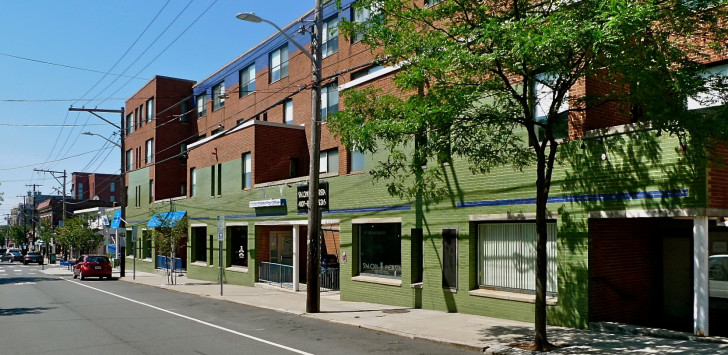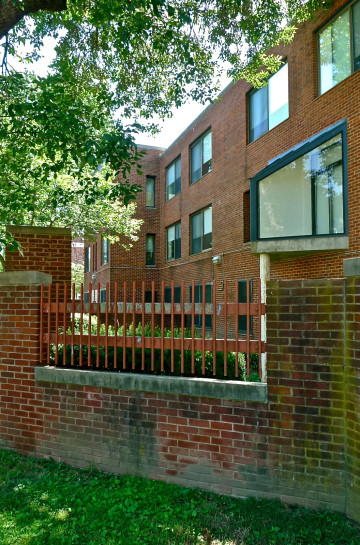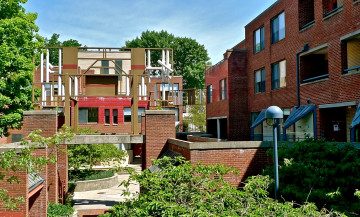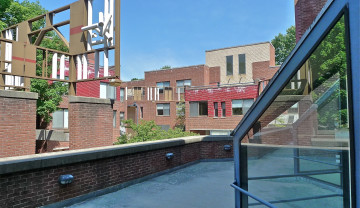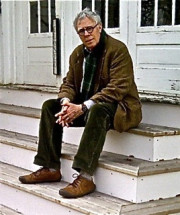Architectural Triumph on Thayer Street
Tuesday, July 26, 2016
- Name a Brown University building that was on the cover of a national architectural journal.
- Name a local work of architecture by the designers of the iconic Sea Ranch in northern California, winner of the American Institute of Architects Twenty-five Year Award in 1991.
GET THE LATEST BREAKING NEWS HERE -- SIGN UP FOR GOLOCAL FREE DAILY EBLAST- Name the most distinguished piece of architectural design on the commercial stretch of Thayer Street.
- Name the forty-something-year-old work of Modern architecture at Brown that best interacts with the neighborhood and contributes to the life of the street.
- Name the dormitories that university scion John Nicholas Brown, Jr. insisted speak "a language that reflected the most creative thinking of the day."
- Name the building whose interior courtyard is described as "having the liveliness of an Italian hill village."
- Name the Brown building that makes 257 Thayer–the paper-thin new student-ghetto apartments–look aggressively banal.
The answer to all these questions is the dormitory and commercial block on Thayer Street that houses Ocean State Coffee Roasters and the Eastside branch of the Post Office.
Officially called New Pembroke Dormitories, the architectural gem that deserves such praise was designed in the late 1960s and completed in 1975. After decades of Williamsburg-wannabe Georgian-style dormitories, as well as some milquetoast Modernism, this complex marked an innovative approach that typified not only its freewheeling San Francisco designers, but also the optimism, idealism, and craziness of the 1960s.
New Pembroke's Princeton-educated designer Donlyn Lyndon was a partner at the radical Bay Area firm of MLTW (M was Charles Moore, a founder of Post-Modernism, Yale architecture school dean, and recipient of the AIA Gold medal). Lyndon shaped a contemporary four-story block that offered commercial rental space on the ground floor. Having several small stores, such as a salon or a post office, brings more activity to the street. Lyndon respected the residential nature of the Bowen Street side by setting the building back from the street, employing just three stories, and adding a partially open wall to offer a more domestic feel. Looking back, the 80year-old Berkeley, California architect notes, "I am still very proud of Pembroke."
Bowen Street front of New Pembroke. A combination of German worker housing and warm New England brick. The glass box punched in the wall is an ironic riff on a traditional Oriel window.
Funds from the Department of Housing and Urban Development with a dollar-per-student ratio would have led some architects to do everything on the cheap. Instead, Lyndon chose to be creative with inexpensive materials and ingenious planning. His Thayer Street façade was given a bit of fun by the use of colored glazed bricks.
If the commercial side of New Pembroke smiles at the town, the part devoted to student living is an introverted, protective courtyard. The three units of New Pembroke are arranged to form a sanctuary from the hectic life of the Thayer Street that is in keeping with similar but more traditional quadrangles elsewhere on campus.
Instead of a flat piece of greenery, Lyndon built a winding path from the northeast corner to the older Pembroke dorms to the southwest. This complicated passageway is a serendipitous journey, framed by entrances, steps, staircases, balconies, and all manner of places to sit. The center is dominated by a giant sculpture composed of steel beams and plastic pipes by Lyndon's wife Alice Wingwall. Ray Rhinehart, author of the Princeton Architectural Press' guide to Brown likens this composition to a Tinker Toy construction, and says of the whole, "It is as if the architect had called recess and sent the architecture out to play."
Courtyard with Alice Wingwall sculpture, which the artist designed to "provide changing light, play, and shadow in the courtyard as the times of day and seasons pass."
Rhinehart's Italian hill village analogy is right on. One suspects that today's Brown student hasn't the time or inclination to sit on the stoop, smoke, and shoot the breeze with dorm mates, watching the passing parade of students. In addition, the university shortsightedly walled up an archway that led from Thayer to the courtyard.
Different surface textures, windows of various shapes and size, and staggered wall heights give the courtyard infinite visual interest.
Different surface textures, windows of various shapes and size, and staggered wall heights give the courtyard infinite visual interest.
New Pembroke earned its place on the cover of Progressive Architecture in January 1970, having beaten out 669 competitors for the magazine's annual Design Award. One of the jurors, Robert Venturi, the anti-Modern polemicist and one of the most influential architects of the century, singled out the Brown dorms' Janus quality, "On the one hand dumb and ordinary, and on the other hand very sophisticated."
New Pembroke needs some long-deferred maintenance, which would enhance appreciation of what the building accomplished and what a groundbreaking design it is. Take the time to find your way to the courtyard, reflect, and then send a letter or a text to Chris Paxson asking Brown to cherish and restore this delightful architectural treasure.




